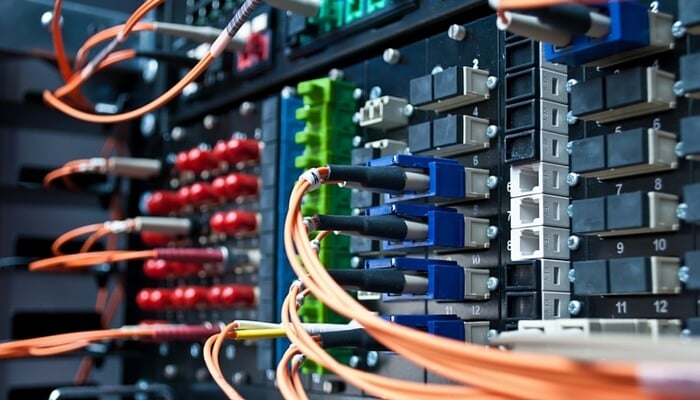Connecting Your Locations with a Point-to-Point Fiber Optic Network
September 28, 2022

Consistency. It yields results in all facets of your business (and life). A fast, reliable, and consistent internet connection is a must in today’s world of instant communication, data sharing, file sharing, and more.
Enter point-to-point fiber optic networks.
Signing on for a point-to-point fiber optic network is an especially logical move when you want to connect different buildings in a campus environment, or if you want high availability and a secure connection to a remote site.
This article will explore how great P2P fiber optic networks work, how they are secured, their benefits, and how much they cost.
Point-to-Point Fiber Optic Networks
If you have a dedicated, point-to-point fiber network connecting two buildings or remote sites, the user experience is as if both machines were on the same LAN.
What happens if you want to back up data from another location?
Well, with P2P, you can handle it from your direct connection.
Also, if you have security concerns, you will be happy to know that P2P (as a dedicated, private connection) is considered to be remarkably secure.
How Do I Know if I Need a Point-to-Point Fiber Network?
Organizations wondering if they need P2P fiber generally need enhanced control, bandwidth, security, or administrative convenience that outweighs the upcharge.
Here are some use cases for P2P Fiber deployments:
- To connect multiple buildings
- Remote workstations require high availability and security
- Equal upload and download bandwidth requirements
If you’re nodding along, you probably need a point-to-point fiber network. You’re likely facing the same challenges as other businesses and enterprises. Maybe your workforce is global. You might have multiple business locations. Your workforce expects to be able to seamlessly connect with colleagues from wherever they are.
4 Benefits of a P2P Fiber Optic Network
1. Faster communications
When you have access to dedicated bandwidth, you naturally end up with higher bandwidth per port. This translates into dramatically faster communications via your point-to-point connection.
Your P2P connection can also run at the same speeds as a LAN connection, whether your cables and switches can handle 100 Mbps, 1000 Mbps, or 10Gbps. You can dive into the work without being delayed by connectivity lags.
2. Equal Bandwidth
Similarly, the technology provides equal bandwidth whether you are uploading or downloading – which is especially important for telecommunications, where audio and video uploads can experience packet bottlenecks that cause stream quality compromises in non-P2P situations.
3. Flexibility
Because P2P technology supports manual controls over bandwidth per port, it gives you the greatest possible flexibility and governance over the connection at your disposal.
4. P2P Fiber Optic Security
The security implications of P2P are of paramount importance. When your office branches and data centers are situated some distance from each other, P2P fiber networks allow them to communicate on a secure connection without your data passing through public peering points or any central hub.
Because P2P simply circumvents those potential security risks, using this type of connection also keeps traffic from other users from slowing things down. After all, with P2P, there are no users other than those you want to connect with.
5. P2P and the Necessity for VPNs
Those connected remotely do not need to worry about using a VPN, which could introduce potential complications.
Once you are set up with a P2P connection, you are good to go, though if you wish to secure your data further, creating a VPN is an available option.
How P2P Fiber Optic Connections Work
Peeking “under the hood,” a point-to-point architecture means that one or two strands of single or multi-mode fiber housed in a multi-fiber cable are fusion spliced together. This forms a contiguous path that connects a switch at the carrier’s central office directly to the carrier’s local aggregation switch located in the customer’s building.
The local aggregation switch has any number of multiple optical ports. These ports are dedicated to a particular customer and connected to the business’s telecommunications room via additional fiber cables run through your building.
This path forms one end of a continuous pathway for signals through each node. Once this work is completed at both ends of the connection, the business receives one long connected fiber loop.
Note that from a practical standpoint, the existing fiber in the building may be reworked to connect from the local aggregation switch to the business location. Sometimes, however, installing new fiber is necessary.
Also, if both ends of the P2P connection are not in the same central office for the carrier, the carrier will use its core fiber network to connect the two central offices.
How Much Does a Point-to-Point Fiber Optic Network Cost?
When a company switches technologies, even when the move improves functioning and saves money, the new technology still entails setup costs.
In the case of a P2P fiber network, you’ll be paying for equipment, the use of the circuit itself, and the labor involved in installing the network on your premises. These are the parameters that contribute to pricing more than any others.
Costs to get started will depend on the difficulty of the installation, the complexity and length of the network, and the extent to which fiber infrastructure is already in place at your various locations.
Your requirements can also influence pricing.
For example, if you need a higher bandwidth (depending on what your company does), you might pay more for the network.
Setup pricing can range from $500 to $2500 or more. Monthly recurring charges are similar.
I recently provisioned a four-site point-to-point network over fiber that included one international site, and setup costs were less than $3000.
Is a P2P Fiber Optic Link the Right Choice?
If you depend on connecting to multiple locations on demand quickly, it makes sense to look into P2P fiber network connectivity for your business.
The technology is best-in-class, the network is secure, a point-to-point network connection is extremely fast, and fiber-carried P2P is widely considered future-proof.
Learn more about Atlantech’s business fiber internet solutions for D.C metro and Northern Virginia businesses. We also recommend downloading our free eBook, The Insider’s Guide to Fiber Internet Connectivity.



